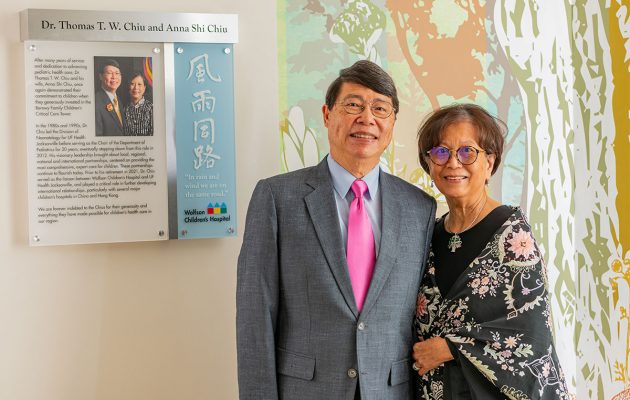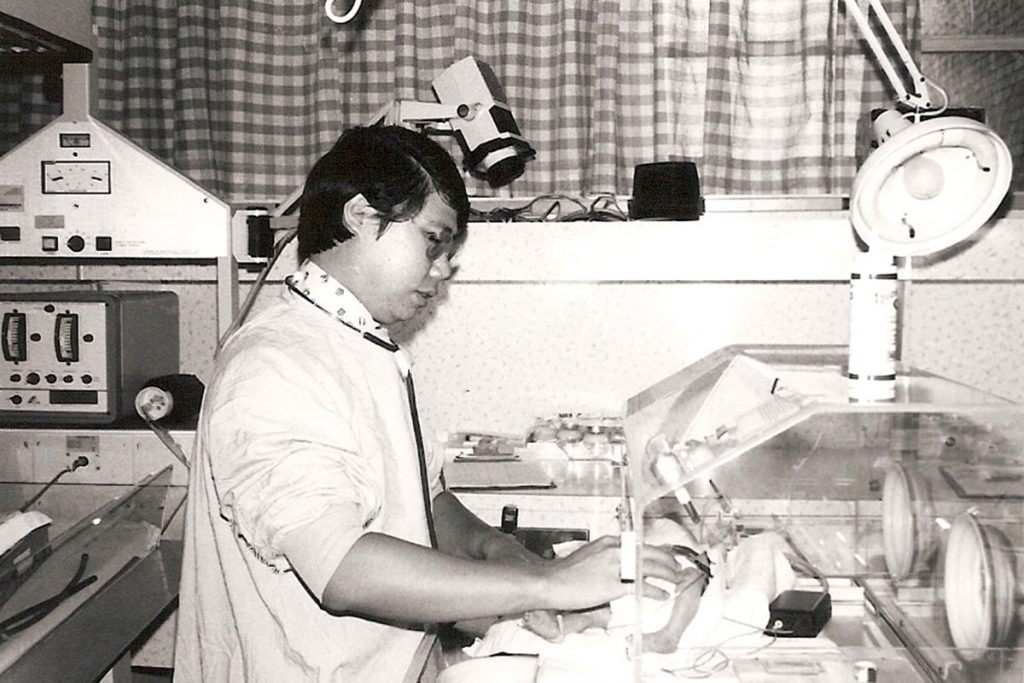Wolfson NICU – 50 Years
Posted on March 4, 2022 By Editor Top Stories

New tower features world-class technology
In the five decades since Wolfson Children’s Hospital opened its first dedicated Neonatal Intensive Care Unit, technology and medical interventions have advanced so remarkably that premature infants are surviving at much lower birth weights than would have been possible in its early years. With the opening this year of the multi-floor Neonatal Intensive Care Center in the Borowy Family Children’s Critical Care Tower, some of the state-of-the-art technology is first of its kind.
“The Critical Care Tower is probably the most modern in the world. When you have no program and now have the best in the country, that is so rewarding,” said neonatologist Thomas W. Chiu, M.D., M.B.A., Wolfson NICU’s first medical director who remained involved until his retirement at the end of 2021. Fifty years ago saving the life of a 2-pound baby born at 28 weeks would have been a miracle, he said; now some born as early as 22 weeks and weighing less than a pound can survive and thrive.
In addition to the latest technology and highly skilled neonatologists, having a well-trained team that includes nurses, laboratory technicians, social workers and others is critical, said Chiu, emeritus professor, University of Florida College of Medicine – Jacksonville.
The Technology
Wolfson President Michael Aubin called advances in the NICU’s technology mind-boggling. Computer monitors in spacious patient rooms display data doctors don’t yet know is a cause for concern and parents can monitor the care of their newborns anywhere on smartphones.
Aubin said the most significant technical enhancement in the building is the predictive analytics system developed in a relationship with Philips, a global health care technology company. “The first to be rolled out in the neonatal environment is right here in Jacksonville,” he said. “It talks to other equipment in the room and collects lots of information.”
Using complex algorithms, the system monitors an enormous amount of patient information, including laboratory and X-ray results, and alerts staff of negative trends that have not yet hit a critical status.
“It allows our practitioners to touch a screen and see charts showing trend lines of all the major organ systems of the body and know that if they don’t act now, the baby may have a stroke or go into heart failure or respiratory distress,” Aubin said. “We are so excited because we will also be working in partnership with Philips to further develop this system and identify other things we can add to help predict before they happen.”
The tower’s state-of-the-art technology also includes a neonatal MRI system designed for imagining the developing brains of tiny newborns. “We are the third hospital in the country to get it. The first was at Harvard and the second was at Yale,” said Aubin.
The Old Days
From incubators where the babies sleep to iPads used to close the blinds, differences in the NICU’s early and modern days are astonishing. “They’re like little space capsules,” said Aubin of the current incubators, “like a womb outside of the womb for these very premature babies that keeps them safe and temperature controlled.”
Cherie Baker, R.N., B.S.N., head nurse in the NICU from 1977 to 1979, recalls the latest development then being a radiant warmer, an open bed with a warmer on top. “You taped a probe on the baby’s stomach that would tell you what their temperature was and the radiant warmer on top would increase or decrease, as needed,” she said. “Before that, you had to reach in and do everything.”
Another device, vastly improved today, was the CPAP (continuous positive airway pressure) machine used to provide respiratory support to neonates. “They had glass bottles that were taped to the floor so nobody would knock them over,” Baker said. “Hoses went over the radiant warmer.”
Compared to the spectacular three-story NICU, the four-room NICU of the 1970s was miniscule. Baker said it had a large center room with a computer, tiny kitchen area and room with 11 beds for the sickest newborns.
“The whole NICU in the ‘70s was a little bit more than 1,000 square feet. Now, one of the rooms to manage one baby is over 1,000 square feet,” said Chiu.

Before going to Wolfson, Baker had worked with Chiu in the NICU at the University Hospital of Jacksonville, later called Shands Jacksonville and now UF Health. She participated in air transports around Florida and Georgia to pick up babies in need of specialized neonatal care. Although Chiu had been deeply involved with the Wolfson NICU its entire existence, he served on the UF faculty and was instrumental in bringing several Jacksonville hospitals together to provide neonatology services in the 1970s.
Chiu played a major role in forming the City Wide Neonatal Program where pediatricians and other specialists from University, Wolfson, Memorial, St. Vincent’s, Riverside and Orange Park hospitals shared resources. They trained nurse practitioners to do NICU work, scheduled neonatologists around the clock and became a national model. Wolfson soon emerged as the city’s main NICU, largely because of its surgical, neurological, cardiac and other support.
“All surgery of neonates basically is done at Wolfson now,” said Chiu.
“I could not have imagined what the NICU has today,” said Baker, regional director for Spark Pediatrics. “I learned a lot from Dr. Chiu. He was so diplomatic with everyone and he could get things done.”
Family Support
Throughout the Wolfson NICU’s history, strong family support has been its priority. Features in the new tower that cater to families are significantly enhanced just in comparison to the most recent NICU that could hold nearly 60 babies but had little or no facilities for families. It had no ability for parents to stay overnight and even the 20-bed Pediatric ICU had no private bathrooms.
In the tower, each patient room has a bed that sleeps two adults, full bathroom, storage area, large wardrobe and its own private lobby/lounge where siblings can play. A series of security systems protects families and parents are involved in their children’s care 24/7.
The ability for families to stay comfortably with their children and participate as partners in their care is the most important part of the new NICU, Aubin said: “The average length of stay is 25 days. Research shows when a neonate has parents there and parents can have kangaroo skin-to-skin care, the baby’s immune system develops faster, they grow faster and the length of stay is reduced.”
“As excited as we are about the new building and all the features, it’s the staff that takes care of these patients that makes all the difference in the world,” Aubin added. “Without them, it’s just a building.”
New tower honors Borowy family
The magnificent building that serves as the new “front door” to the expanded campus of Baptist Medical Center Jacksonville and Wolfson’s Children’s Hospital features world-class technology that saves lives of critically ill and injured infants and children.
Five of the seven floors of the 225,000-square-foot Borowy Family Children’s Critical Care Tower are dedicated to high-level children’s care:
- Three-story Neonatal Intensive Care Center with three separate Neonatal Intensive Care Units on three floors
- Pediatric Intensive Care Unit that includes a Neuro-Intensive Care Unit
- Cardiovascular Intensive Care Unit
- Specialty Burn & Wound Care Unit
- The $224 million expansion project started in May 2019 and a phased opening began in February.
“They have a special place in their hearts for children,” said Wolfson President Michael Aubin of Dr. Thom and Pat Borowy and their children, Hayden Borowy and Megan Borowy Walker and son-in-law Mark Walker. “The family has been very philanthropically supportive in numerous areas across Baptist for many years. They knew we needed a significant gift to be able to provide all the technology we wanted to put into the new building. So they stepped up and made that significant gift which we honored by naming the critical care tower in their honor.”
The first two floors are the lobby. The new entrance includes an 85-foot skybridge from the P2 parking garage across Palm Avenue, which makes a dramatic statement that showcases artwork and donor recognition spaces. State-of-the-art technology ranges from a neonatal MRI system to humidity-controlled rooms to prevent infection in the burn unit in the Pediatric ICU.
“It’s a fascinating place,” said Aubin. “We tried to think about every little detail.”
Aubin credits The Women’s Board for raising funds for many of Wolfson’s advances. “They have been working on the development of a tremendous endowment that will help us support that going forward,” he said.
How to help: To contribute to Wolfson’s Hope Starts Here campaign to transform the delivery of critical care for infants and children, access hopestartshere.com. For questions or to make dedicated gifts to Wolfson, call (904) 202-6296.
By Lorrie DeFrank
Resident Community News




 (No Ratings Yet)
(No Ratings Yet)Baptist Medical Center Jacksonville, Borowy Family Children's Critical Care Tower, Cherie Baker, Hope Starts Here, Michael Aubin, Neonatal Intensive Care Unit, Thomas Chiu, Wolfson Children's Hospital, Wolfson NICU





